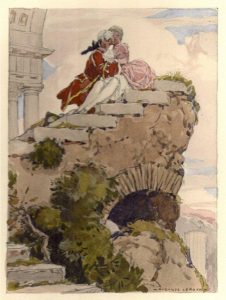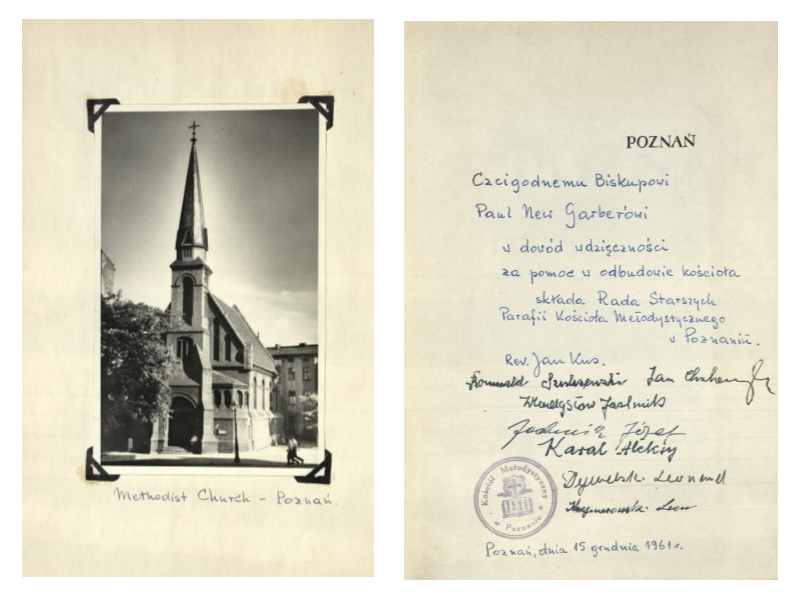We’ve added some exciting new books to our Pop Collection, just in time for Spring Break. Stop by the McGraw-Page Library and check one out for a relaxing read!
The Hate U Give
by Angie Thomas
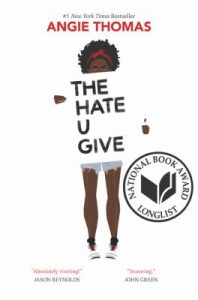 Sixteen-year-old Starr Carter moves between two worlds: the poor neighborhood where she lives and the fancy suburban prep school she attends. The uneasy balance between these worlds is shattered when Starr witnesses the fatal shooting of her childhood best friend Khalil at the hands of a police officer. Khalil was unarmed. Soon afterward, his death is a national headline. Some are calling him a thug, maybe even a drug dealer and a gangbanger. Protesters are taking to the streets in Khalil’s name. Some cops and the local drug lord try to intimidate Starr and her family. What everyone wants to know is: what really went down that night? And the only person alive who can answer that is Starr. But what Starr does or does not say could upend her community. It could also endanger her life.
Sixteen-year-old Starr Carter moves between two worlds: the poor neighborhood where she lives and the fancy suburban prep school she attends. The uneasy balance between these worlds is shattered when Starr witnesses the fatal shooting of her childhood best friend Khalil at the hands of a police officer. Khalil was unarmed. Soon afterward, his death is a national headline. Some are calling him a thug, maybe even a drug dealer and a gangbanger. Protesters are taking to the streets in Khalil’s name. Some cops and the local drug lord try to intimidate Starr and her family. What everyone wants to know is: what really went down that night? And the only person alive who can answer that is Starr. But what Starr does or does not say could upend her community. It could also endanger her life.
POP PS 3620 .H62463 H38 2017
Catalog Link – The Hate U Give
Bone Gap
by Laura Ruby
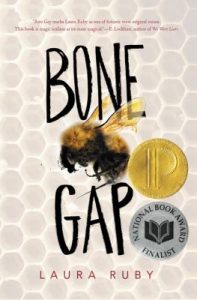 Eighteen-year-old Finn, an outsider in his quiet Midwestern town, is the only witness to the abduction of town favorite Roza, but his inability to distinguish between faces makes it difficult for him to help with the investigation, and subjects him to even more ridicule and bullying.
Eighteen-year-old Finn, an outsider in his quiet Midwestern town, is the only witness to the abduction of town favorite Roza, but his inability to distinguish between faces makes it difficult for him to help with the investigation, and subjects him to even more ridicule and bullying.
POP PS 3618 .U28 2015
Catalog Link – Bone Gap
Turtles All the Way Down
by John Green
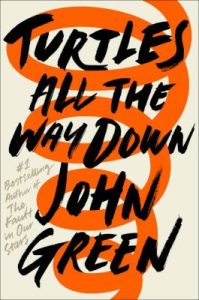 Sixteen-year-old Aza never intended to pursue the mystery of fugitive billionaire Russell Pickett, but there’s a hundred-thousand-dollar reward at stake and her best and most fearless friend, Daisy, is eager to investigate. So together, they navigate the short distance and broad divides that separate them from Russell Pickett’s son, Davis. Aza is trying. She is trying to be a good daughter, a good friend, a good student, and maybe even a good detective, while also living within the ever-tightening spiral of her own thoughts. In his long-awaited return, John Green, the acclaimed, award-winning author of Looking for Alaska and The Fault in Our Stars, shares Aza’s story with shattering, unflinching clarity in this brilliant novel of love, resilience, and the power of lifelong friendship.
Sixteen-year-old Aza never intended to pursue the mystery of fugitive billionaire Russell Pickett, but there’s a hundred-thousand-dollar reward at stake and her best and most fearless friend, Daisy, is eager to investigate. So together, they navigate the short distance and broad divides that separate them from Russell Pickett’s son, Davis. Aza is trying. She is trying to be a good daughter, a good friend, a good student, and maybe even a good detective, while also living within the ever-tightening spiral of her own thoughts. In his long-awaited return, John Green, the acclaimed, award-winning author of Looking for Alaska and The Fault in Our Stars, shares Aza’s story with shattering, unflinching clarity in this brilliant novel of love, resilience, and the power of lifelong friendship.
POP PS 3607 .R432928 Z84 2017
Catalog Link – Turtles All the Way Down
Symptoms of Being Human
by Jeff Garvin
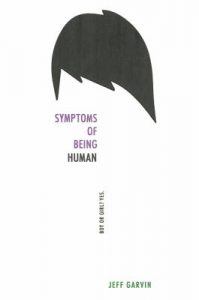 Riley Cavanaugh is many things: Punk rock. Snarky. Rebellious. And gender fluid. Some days Riley identifies as a boy, and others as a girl. But Riley isn’t exactly out yet. And between starting a new school and having a congressman father running for reelection in über-conservative Orange County, the pressure—media and otherwise—is building up in Riley’s life. On the advice of a therapist, Riley starts an anonymous blog to vent those pent-up feelings and tell the truth of what it’s really like to be a gender fluid teenager. But just as Riley’s starting to settle in at school—even developing feelings for a mysterious outcast—the blog goes viral, and an unnamed commenter discovers Riley’s real identity, threatening exposure. And Riley must make a choice: walk away from what the blog has created—a lifeline, new friends, a cause to believe in—or stand up, come out, and risk everything.
Riley Cavanaugh is many things: Punk rock. Snarky. Rebellious. And gender fluid. Some days Riley identifies as a boy, and others as a girl. But Riley isn’t exactly out yet. And between starting a new school and having a congressman father running for reelection in über-conservative Orange County, the pressure—media and otherwise—is building up in Riley’s life. On the advice of a therapist, Riley starts an anonymous blog to vent those pent-up feelings and tell the truth of what it’s really like to be a gender fluid teenager. But just as Riley’s starting to settle in at school—even developing feelings for a mysterious outcast—the blog goes viral, and an unnamed commenter discovers Riley’s real identity, threatening exposure. And Riley must make a choice: walk away from what the blog has created—a lifeline, new friends, a cause to believe in—or stand up, come out, and risk everything.
POP PS 3607 .A782895 S9 2016
Catalog Link – Symptoms of Being Human
Simon vs. the Homo Sapiens Agenda
by Becky Albertalli
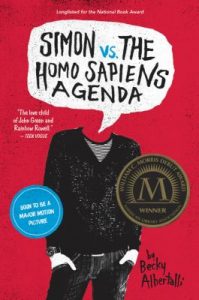 Sixteen-year-old and not-so-openly gay Simon Spier prefers to save his drama for the school musical. But when an email falls into the wrong hands, his secret is at risk of being thrust into the spotlight. Now change-averse Simon has to find a way to step out of his comfort zone before he’s pushed out—without alienating his friends, compromising himself, or fumbling a shot at happiness with the most confusing, adorable guy he’s never met.
Sixteen-year-old and not-so-openly gay Simon Spier prefers to save his drama for the school musical. But when an email falls into the wrong hands, his secret is at risk of being thrust into the spotlight. Now change-averse Simon has to find a way to step out of his comfort zone before he’s pushed out—without alienating his friends, compromising himself, or fumbling a shot at happiness with the most confusing, adorable guy he’s never met.
POP PS 3551 .L257 S5 2015
Catalog Link – Simon vs. The Homo Sapiens Agenda
We Are Okay
by Nina LaCour
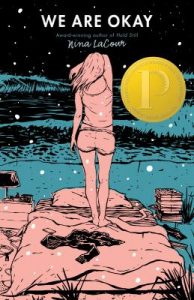 Marin has picked up and left everything behind in California, carrying only her phone, her wallet, and a picture of her mother. Now she’s in college, and her former friend Mabel is coming to visit. Marin will be forced to confront her grief and the truths that caused her to flee her home.
Marin has picked up and left everything behind in California, carrying only her phone, her wallet, and a picture of her mother. Now she’s in college, and her former friend Mabel is coming to visit. Marin will be forced to confront her grief and the truths that caused her to flee her home.
POP PS 3612.A36 W4 2017
Catalog Link – We Are Okay

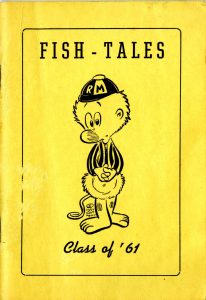


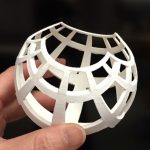

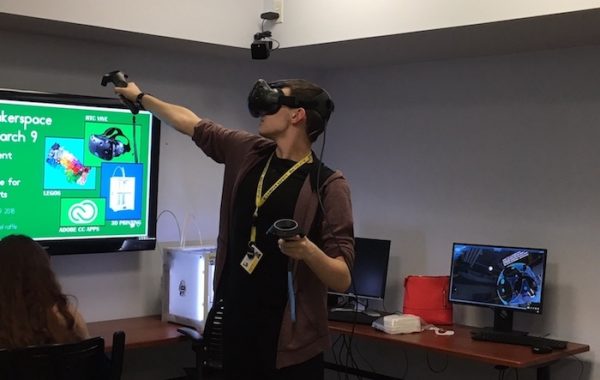


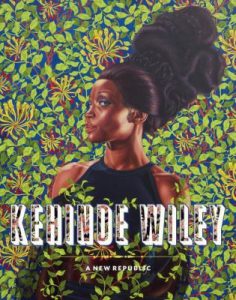 The works presented in Kehinde Wiley: A New Republic raise questions about race, gender, and the politics of representation by portraying contemporary African American men and women using the conventions of traditional European portraiture. The exhibition includes an overview of the artist’s prolific fourteen-year career and features sixty paintings and sculptures. Wiley’s signature portraits of everyday men and women riff on specific paintings by Old Masters, replacing the European aristocrats depicted in those paintings with contemporary black subjects, drawing attention to the absence of African Americans from historical and cultural narratives. The subjects in Wiley’s paintings often wear sneakers, hoodies, and baseball caps, gear associated with hip-hop culture, and are set against contrasting ornate decorative backgrounds that evoke earlier eras and a range of cultures. Through the process of “street casting,” Wiley invites individuals, often strangers he encounters on the street, to sit for portraits. In this collaborative process, the model chooses a reproduction of a painting from a book and reenacts the pose of the painting’s figure. By inviting the subjects to select a work of art, Wiley gives them a measure of control over the way they’re portrayed.
The works presented in Kehinde Wiley: A New Republic raise questions about race, gender, and the politics of representation by portraying contemporary African American men and women using the conventions of traditional European portraiture. The exhibition includes an overview of the artist’s prolific fourteen-year career and features sixty paintings and sculptures. Wiley’s signature portraits of everyday men and women riff on specific paintings by Old Masters, replacing the European aristocrats depicted in those paintings with contemporary black subjects, drawing attention to the absence of African Americans from historical and cultural narratives. The subjects in Wiley’s paintings often wear sneakers, hoodies, and baseball caps, gear associated with hip-hop culture, and are set against contrasting ornate decorative backgrounds that evoke earlier eras and a range of cultures. Through the process of “street casting,” Wiley invites individuals, often strangers he encounters on the street, to sit for portraits. In this collaborative process, the model chooses a reproduction of a painting from a book and reenacts the pose of the painting’s figure. By inviting the subjects to select a work of art, Wiley gives them a measure of control over the way they’re portrayed.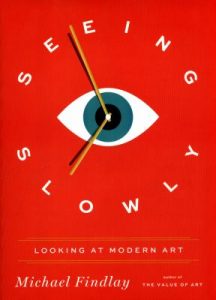 When it comes to viewing art, living in the information age is not necessarily a benefit. So argues Michael Findlay in this book that encourages a new way of looking at art. Much of this thinking involves stripping away what we have been taught and instead trusting our own instincts, opinions, and reactions. Including reproductions of works by Mark Rothko, Paul Klee, Joan Miro , Jacob Lawrence, and other modern and contemporary masters, this book takes readers on a journey through modern art. Chapters such as “What Is a Work of Art?” “Can We Look and See at the Same Time?” and “Real Connoisseurs Are Not Snobs,” not only give readers the confidence to form their own opinions, but also encourages them to make connections that spark curiosity, intellect, and imagination. “The most important thing for us to grasp,” writes Findlay, “is that the essence of a great work of art is inert until it is seen. Our engagement with the work of art liberates its essence.” After reading this book, even the most intimidated art viewer will enter a museum or gallery feeling more confident and leave it feeling enriched and inspired.
When it comes to viewing art, living in the information age is not necessarily a benefit. So argues Michael Findlay in this book that encourages a new way of looking at art. Much of this thinking involves stripping away what we have been taught and instead trusting our own instincts, opinions, and reactions. Including reproductions of works by Mark Rothko, Paul Klee, Joan Miro , Jacob Lawrence, and other modern and contemporary masters, this book takes readers on a journey through modern art. Chapters such as “What Is a Work of Art?” “Can We Look and See at the Same Time?” and “Real Connoisseurs Are Not Snobs,” not only give readers the confidence to form their own opinions, but also encourages them to make connections that spark curiosity, intellect, and imagination. “The most important thing for us to grasp,” writes Findlay, “is that the essence of a great work of art is inert until it is seen. Our engagement with the work of art liberates its essence.” After reading this book, even the most intimidated art viewer will enter a museum or gallery feeling more confident and leave it feeling enriched and inspired.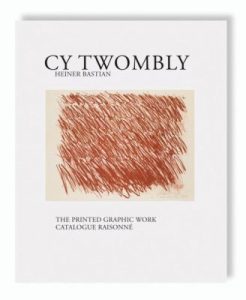 Cy Twombly was one of the most fascinating and remarkable artists of our time. His ceuvre, the paintings sculptures, drawings, photographs, and prints have been widely exhibited, both in America and Europe. His worldwide recognition is still growing. Twombly’s art reconciles grand themes of the memoriae of ancient topographies as well as modernism with the individual, personal experience of contemporary life. Seldom has an artist achieved such a distinctive, broad range of an ever new, surprisingly unique language, exploring and celebrating the poetic possibility of painting and drawing.
Cy Twombly was one of the most fascinating and remarkable artists of our time. His ceuvre, the paintings sculptures, drawings, photographs, and prints have been widely exhibited, both in America and Europe. His worldwide recognition is still growing. Twombly’s art reconciles grand themes of the memoriae of ancient topographies as well as modernism with the individual, personal experience of contemporary life. Seldom has an artist achieved such a distinctive, broad range of an ever new, surprisingly unique language, exploring and celebrating the poetic possibility of painting and drawing.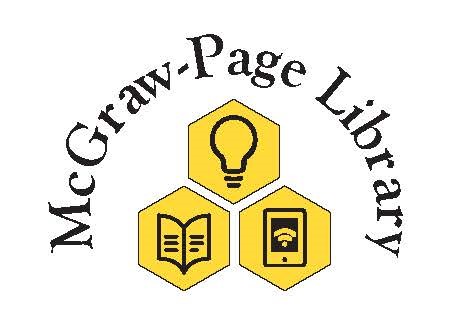 I am pleased to introduce the new McGraw-Page Library logo. This logo represents several months of collaboration with the
I am pleased to introduce the new McGraw-Page Library logo. This logo represents several months of collaboration with the 